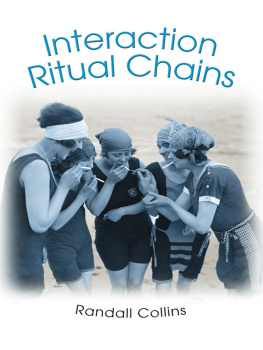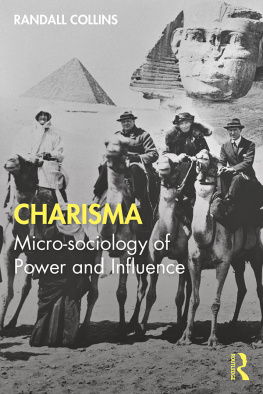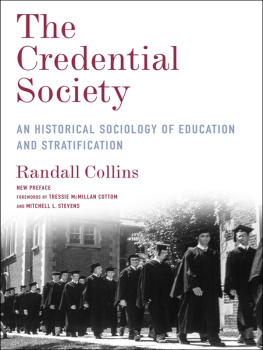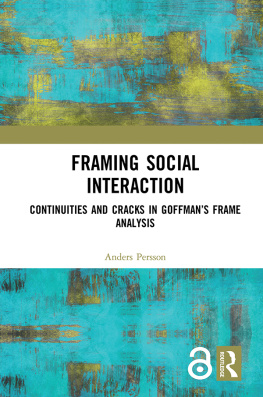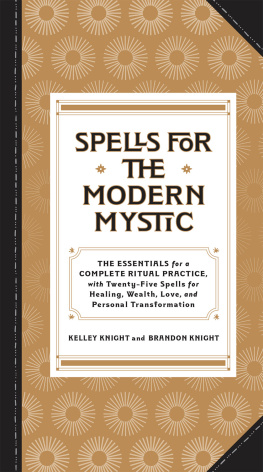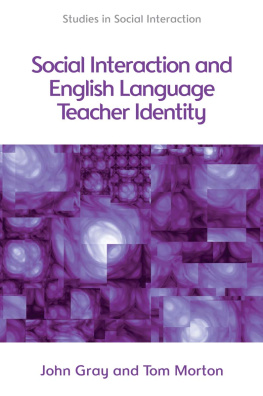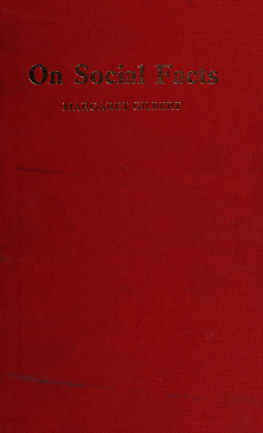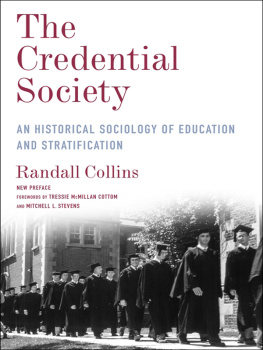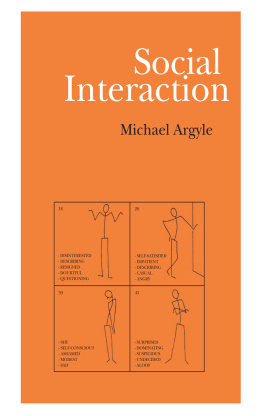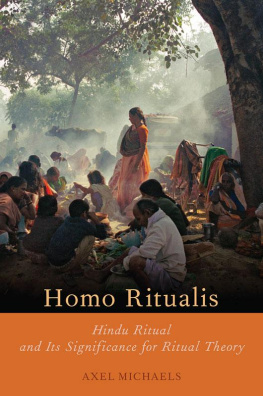
Interaction Ritual Chains
_________________________
PRINCETON STUDIES IN CULTURAL SOCIOLOGY
Editors
Paul J. DiMaggio
Michle Lamont
Robert J. Wuthnow
Viviana A. Zelizer
A list of titles in this series appears at the back of the book.
Interaction Ritual Chains
Randall Collins
PRINCETON UNIVERSITY PRESS
PRINCETON AND OXFORD
Copyright 2004 by Princeton University Press
Published by Princeton University Press, 41 William Street, Princeton, New Jersey 08540
In the United Kingdom: Princeton University Press, 3 Market Place, Woodstock, Oxfordshire OX20 1SY
All Rights Reserved
Second printing, and first paperback printing, 2005
Paperback ISBN-13: 978-0-691-12389-9
Paperback ISBN-10: 0-691-12389-6
The Library of Congress has cataloged the cloth edition
of this book as follows
Collins, Randall, 1941
Interaction ritual chains / Randall Collins.
p. cm. (Princeton studies in cultural sociology)
Includes bibliographical references and index.
ISBN 0-691-09027-0 (alk. paper)
1. Social interaction. 2. EmotionsSociological aspects. I. Title. II. Series.
HM1111 .C64 2004
302.22dc21 2004041461
British Library Cataloging-in-Publication Data is available
This book has been composed in Palatino
Printed on acid-free paper.
pup.princeton.edu
Printed in the United States of America
3 5 7 9 10 8 6 4 2
CONTENTS
_____________________________
CHAPTER 1
The Program of Interaction Ritual Theory |
CHAPTER 2
The Mutual-Focus / Emotional-Entrainment Model |
CHAPTER 3
Emotional Energy and the Transient Emotions |
CHAPTER 4
Interaction Markets and Material Markets |
CHAPTER 5
Internalized Symbols and the Social Process of Thinking |
CHAPTER 6
A Theory of Sexual Interaction |
CHAPTER 7
Situational Stratification |
CHAPTER 8
Tobacco Ritual and Anti-Ritual: Substance Ingestion as a History of Social Boundaries |
CHAPTER 9
Individualism and Inwardness as Social Products |
FIGURES
_____________________________
PREFACE
_____________________________
THIS BOOK ARGUES for the continuity of a chief theoretical pathway from classic sociology to the present. Durkheim launched sociology on a high theoretical level by providing an explanation for some of the most central questions: what produces social membership, moral beliefs, and the ideas with which people communicate and think. The key is that these are linked together by the same mechanism: ideas are symbols of group membership, and thus culture is generated by the moralwhich is to say emotionalpatterns of social interaction. But whereas Durkheim is usually interpreted, and subjected to criticism, as a global theory of the moral integration of an entire society, I interpret the theory through the eyes of Erving Goffman and the microsociological movement; that is to say, in the spirit of symbolic interaction, ethnomethodology, social constructionism, and sociology of emotions. In their spirit, however, not the letter, since I put the ritual mechanism at the center and try to show how it makes maximal explanatory power out of the insights of these micro-sociological perspectives. Starting with a Durkheimian mechanism, we can see how variations in the intensity of rituals lead to variations in social membership patterns and the ideas that accompany them; all this takes place not on the global level of a society in the large sense but as memberships that are local, sometimes ephemeral, stratified, and conflictual.
I do not insist on the letter of Durkheim or Goffman either, but on the fruitfulness of what we can do with these ideas for theorizing a social world of flux and variation. sketches the intellectual history of the social theory of ritual, with an eye to disencumbering what is most useful in the Durkheim tradition, from interpretations that have grown up around it like vines upon old trees in the jungle. Once having disentangled it, I amalgamate it with what is most useful in radical microsociology. Here Goffman is a pathbreaker, but I do some disentangling, too, to separate out what parts of Goffman are most useful for the current project.
mutual focus of attention occurs, and how much emotional entrainment builds up among the participants. Where mutual focus and entrainment become intense, self-reinforcing feedback processes generate moments of compelling emotional experience. These in turn become motivational magnets and moments of cultural significance, experiences where culture is created, denigrated, or reinforced. I illustrate the process of creating symbols by analyzing a first-hand video recording of the creation of new national symbols during the catastrophe of 9/11/2001. Rituals create symbols in first-order, face-to-face interaction, which constitutes the starting point in an array of further second- and third-order circuits in which symbols can be recirculated. Once infused with situational emotion, symbols can be circulated through networks of conversation, and internalized as thinking within the individual circuits of the mind. Ultimately the intensity of human concern with symbols, ranging from enthusiastic and obsessive to bored and alienated, depends upon periodic repetition of IRs; how meaningful these recirculated symbols are depends on what level of emotional intensity is reached in the first-order social encounters in which those symbols are used. Since we are often confronted with symbols apart from the interactional context that determines how alive they are, I offer some rules for unraveling symbols by tracing them back to the interactional situations in which they acquire what emotional significance they have, and then through their recycling in conversational networks and solitary experience.
emotional energy: these features work together. Hence the stratification of interactioninteracting with people who are higher or lower in power, and interacting from a position of status acceptance or rejectiongives each individual a jolt, upward or downward, to their level of EE. Social structure, viewed up close as a chain of interactional situations, is an ongoing process of stratifying individuals by their emotional energy.
Privilege and power is not simply a result of unequal material and cultural resources. It is a flow of emotional energy across situations that makes some individuals more impressive, more attractive or dominant; the same situational flow puts other persons in their shadow, narrowing their sources of EE to the alternatives of participating as followers or being relegated passively to the sidelines. Social dominancewhether it takes the form of leadership, popularity, intellectual innovativeness, or physical aggressivenessis often acceded to by others who encounter such a person, because it occurs through emotional processes that pump some individuals up while depressing others.
shows how IRs produce the flow of motivation from situation to situation. I widen IR theory so as to predict what will happen as individuals steer from one situation to another, by borrowing concepts from rational choice theory. Some social theorists may find the mixture uncomfortable or even heretical. On the face of it, the image of the calculating self-interested individual seems at odds with the Durkheimian micro-collectivity with its moral solidarity. My rationale is that rational choice theory is not really a model of situational interaction, but a meso-level theory of what individuals will do over the medium run of situations over a period of time. Choice implies working out alternatives, and in real life these present themselves gradually and through experience over a series of occasions. The anomalies of rational choice analysis arise because individuals in micro-situations do not calculate very well the range of alternatives hypothetically available to them; but calculation is not what is most useful in this model, but rather the propensity of individuals to drift, consciously or unconsciously, toward those situations where there is the greatest payoff of benefits over costs. Humans are not very good at calculating costs and benefits, but they feel their way toward goals because they can judge everything subconsciously by its contribution to a fundamental motive: seeking maximal emotional energy in interaction rituals.
Next page
